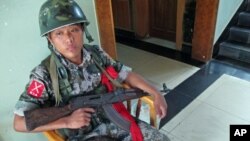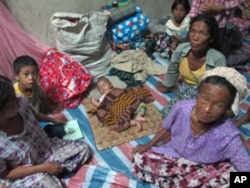Clashes in Burma between an ethnic-based army and government forces are presenting a challenge to the country’s new government, the regime's relationship with its biggest ally, China, and also in its ability to maintain control of resource-rich and strategically important border areas. Although the conflict remains limited to a small region along the Chinese border, it has drawn international attention and public appeals from Burmese democracy leader Aung San Suu Kyi.
In Laiza, a sleepy border town nestled in lush jungles and hills, children are coming home from school, soldiers with rifles on motorbikes are preparing to return to the frontlines, and a Catholic priest is leading a service for internally displaced persons in an IDP camp.
The latter group kneels on the floor, surrounded by children playing, sick people sleeping and families eating in the dusty, smoky hall. The Kachin are devoutly Christian and priests in Laiza have been working overtime to minister to some 7,000 newly arrived refugees in town who have fled nearby fighting.
One refugee described being forced to act as a porter for Burmese troops before the latest violence flared.
Increasing number of displaced persons
He said that in the past, Burmese troops forced him for months to carry heavy loads and ammunition for them. He said he was beaten with a rifle butt for being slow. He said that when the recent tensions started, he just ran away.
Local aid workers say that in all, about 16,000 people have been displaced by the fighting on the Taping River, where a Chinese corporation is building two hydroelectric dams.
Many of those fleeing want to cross into China. However, Chinese officials have refused entry, saying the fighting is not close enough to the border to grant asylum.
La Rip, who founded a refugee association to help people displaced by the conflict, said Burmese troops have emptied villages by threatening violence against locals if they are attacked by the ethnic militia known as the Kachin Independence Army.
“The Burmese army already came in the village and dug a bunker in front of houses, and threatened them," said Rip. "If the KIA shoots us, we’ll burn down the whole village. That village is very close to Laiza.”
KIA, Burmese troops clash
The Burmese government accuses the KIA of starting the conflict in June by attacking the Chinese-built dam. The KIA insists government forces started hostilities as early as May, when they fired mortars at their bases, and says its troops have responded only defensively.
Kachin commanders say the fighting has meant an end to a 17-year-old ceasefire intended to prevent large-scale clashes between Burmese forces and the ethnic militia.
Kachin militia commander Chyana Zaw Awn said the Burmese officials are using the construction of the dams as an excuse to go after his forces, because they refused to become border guards, working under the military.
“The source of the conflict is the refusal of the border guard force proposal," he said. "Since we reject that proposal, they have been looking for a way to ignite the conflict. So they have used the security of the Chinese investments as an excuse. We believe that they have planned from the beginning to eliminate the ethnic troops. It is the Burmese government’s strategic plan to eliminate the ethnic armies."
Pleas for peace
U.S. and Chinese officials have urged all parties to settle the conflict peacefully. The conflict also has drawn in Burmese democracy leader Aung San Suu Kyi. Last month, the Nobel laureate wrote an open letter to Burma’s President Thein Sein appealing for peace talks.
The KIA’s vice chief of staff, General Gun Maw, has been pushing for a new ceasefire agreement to bring an end to the conflict. But he is seeking discussions covering much more than the conflict in Laiza.
“We want a nationwide ceasefire in all conflict areas, and then we’d like to move toward political dialogue," said Maw. "They seem to be happy to discuss peace, but don’t mention politics. They want a ceasefire, but are not willing to engage in political dialogue. What we want is real, genuine federalism. This word scares the Burmese.”
It is unclear how much leverage the KIA has to force the government to the negotiating table. Despite calls from Aung San Suu Kyi and others inside Burma for the government to discuss the standoff, officials have been unwilling to directly talk to the group. The government has appointed two envoys to talk to the militias, but they do not have the authority to negotiate.
Maw warns that his forces will escalate fighting if the standoff continues. “We are ready to go back to guerilla warfare, if it comes to that, we are ready to carry on the revolution. I believe the biggest battle has not yet been fought. The main thing is, they want to eliminate the ethnic groups,” he said.
Kachin state is not a densely populated area. Laiza has a population of about 10,000 people. The state is slightly larger than 89,000 square kilometers, a fraction of which is KIA-controlled territory. All urban areas are controlled by the Burmese government, as well as key mining areas and rivers, which the KIA was required to hand over as part of the 1994 ceasefire.
Sixty-three year-old Burma-analyst Aung Kyaw Zaw was once a soldier and a member of the Burma Communist Party. He stresses the importance of Kachin state’s location between India and China, and points up that it is where headwaters of the country’s vital Irawaddy river flow south.
“KIA is the very clever insurgent in the northeast," he said. "They know international politics and the Burmese politics and Chinese politics. It is not easy to face Kachin leaders.”
Strategic resources in play
Resource-rich Kachin state, littered with gold and jade mines, teakwood, rubber and banana plantations, is small but potentially profitable. Htoo Trading, a conglomerate owned by one of Burma’s richest business men, U Tayza, has a joint venture with a Russian mining company searching for uranium near local jade mines.
Outside analysts say they are watching to see if the militias will be able to broaden their struggle against Burma’s military to involve other ethnic groups. Ahnan is a spokesperson from the environmental watchdog group, Burma Rivers Network, who said other ethnic groups feel the Burmese government is cutting them out of lucrative projects, such as the hydroelectric dams.
“A lot of anger [is] happening around the country, and also some of the development projects in ethnic areas, so it’s really possible civil conflict happens inside the country,” said Ahnan.
KIA commanders in Laiza expect the fighting to increase when the rainy season ends in September. Maw said he believes much of the fighting is still ahead.












